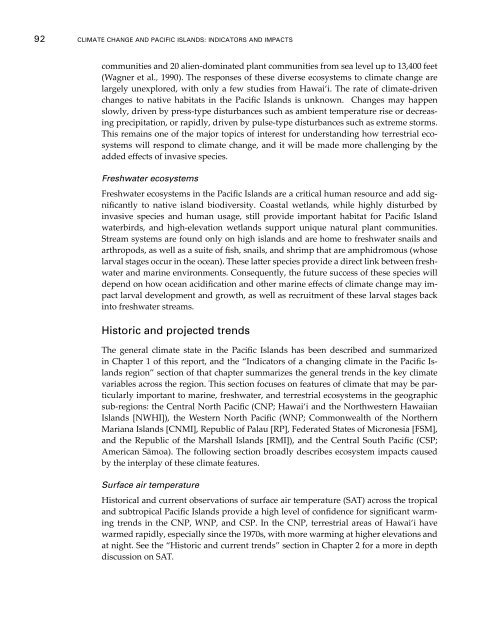(PIRCA), this report - Climate Adaptation Knowledge Exchange
(PIRCA), this report - Climate Adaptation Knowledge Exchange
(PIRCA), this report - Climate Adaptation Knowledge Exchange
You also want an ePaper? Increase the reach of your titles
YUMPU automatically turns print PDFs into web optimized ePapers that Google loves.
92 <strong>Climate</strong> Change and Pacific Islands: Indicators and Impacts<br />
communities and 20 alien-dominated plant communities from sea level up to 13,400 feet<br />
(Wagner et al., 1990). The responses of these diverse ecosystems to climate change are<br />
largely unexplored, with only a few studies from Hawai‘i. The rate of climate-driven<br />
changes to native habitats in the Pacific Islands is unknown. Changes may happen<br />
slowly, driven by press-type disturbances such as ambient temperature rise or decreasing<br />
precipitation, or rapidly, driven by pulse-type disturbances such as extreme storms.<br />
This remains one of the major topics of interest for understanding how terrestrial ecosystems<br />
will respond to climate change, and it will be made more challenging by the<br />
added effects of invasive species.<br />
Freshwater ecosystems<br />
Freshwater ecosystems in the Pacific Islands are a critical human resource and add significantly<br />
to native island biodiversity. Coastal wetlands, while highly disturbed by<br />
invasive species and human usage, still provide important habitat for Pacific Island<br />
waterbirds, and high-elevation wetlands support unique natural plant communities.<br />
Stream systems are found only on high islands and are home to freshwater snails and<br />
arthropods, as well as a suite of fish, snails, and shrimp that are amphidromous (whose<br />
larval stages occur in the ocean). These latter species provide a direct link between freshwater<br />
and marine environments. Consequently, the future success of these species will<br />
depend on how ocean acidification and other marine effects of climate change may impact<br />
larval development and growth, as well as recruitment of these larval stages back<br />
into freshwater streams.<br />
Historic and projected trends<br />
The general climate state in the Pacific Islands has been described and summarized<br />
in Chapter 1 of <strong>this</strong> <strong>report</strong>, and the “Indicators of a changing climate in the Pacific Islands<br />
region” section of that chapter summarizes the general trends in the key climate<br />
variables across the region. This section focuses on features of climate that may be particularly<br />
important to marine, freshwater, and terrestrial ecosystems in the geographic<br />
sub-regions: the Central North Pacific (CNP; Hawai‘i and the Northwestern Hawaiian<br />
Islands [NWHI]), the Western North Pacific (WNP; Commonwealth of the Northern<br />
Mariana Islands [CNMI], Republic of Palau [RP], Federated States of Micronesia [FSM],<br />
and the Republic of the Marshall Islands [RMI]), and the Central South Pacific (CSP;<br />
American Sāmoa). The following section broadly describes ecosystem impacts caused<br />
by the interplay of these climate features.<br />
Surface air temperature<br />
Historical and current observations of surface air temperature (SAT) across the tropical<br />
and subtropical Pacific Islands provide a high level of confidence for significant warming<br />
trends in the CNP, WNP, and CSP. In the CNP, terrestrial areas of Hawai‘i have<br />
warmed rapidly, especially since the 1970s, with more warming at higher elevations and<br />
at night. See the “Historic and current trends” section in Chapter 2 for a more in depth<br />
discussion on SAT.

















